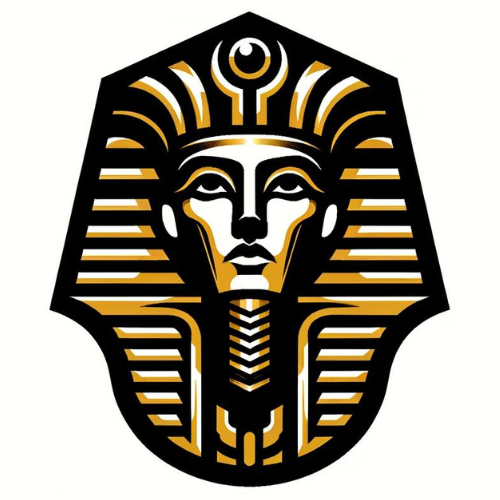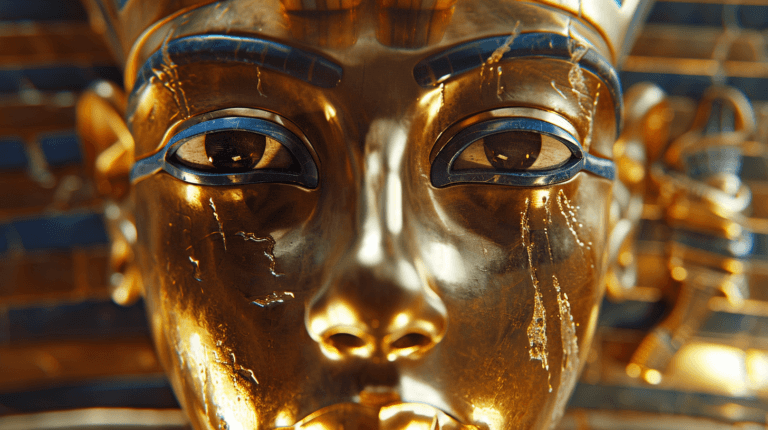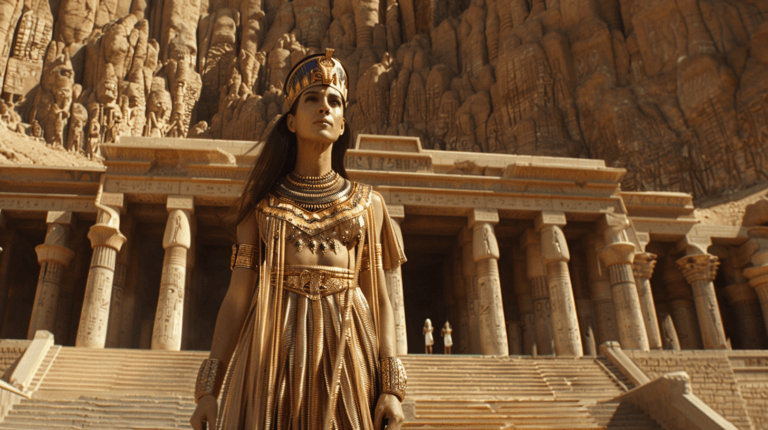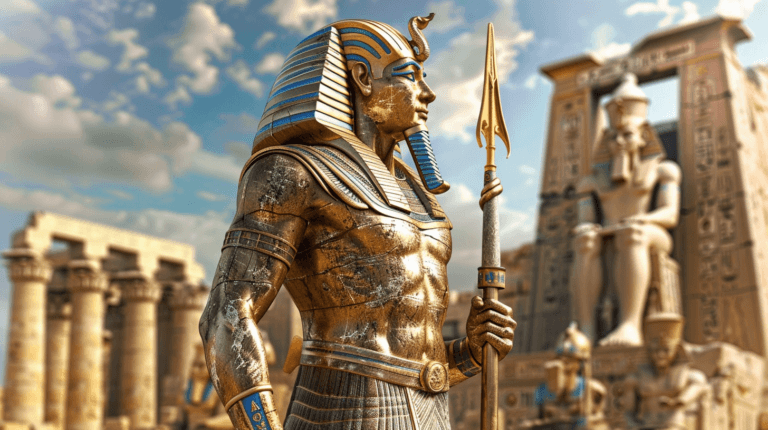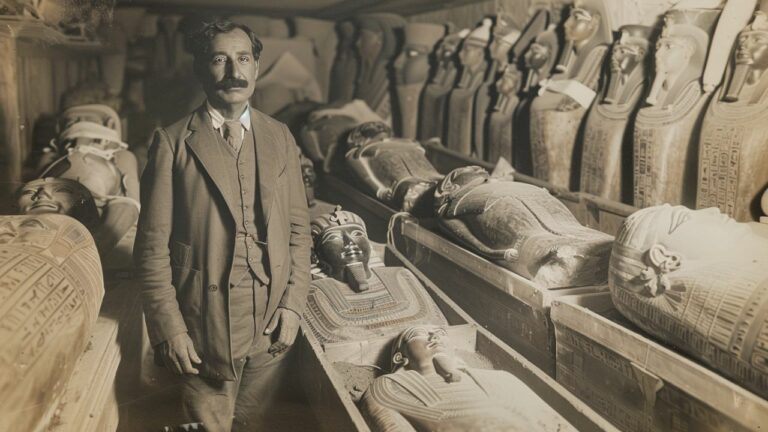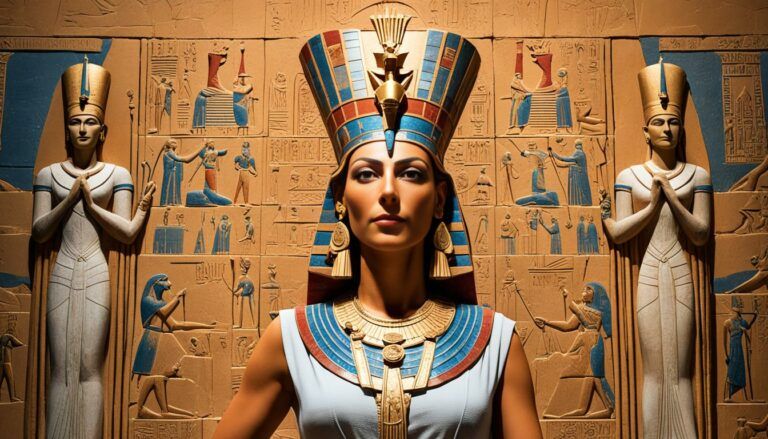The First Pharaoh Narmer (or Menes)
Did you know that the origins of ancient Egypt and its rich civilization can be traced back over 5,000 years? At the heart of this remarkable history lies the enigmatic figure of the first pharaoh Narmer. Often considered to be the same person as Menes, Narmer played a pivotal role in the unification of Egypt and the establishment of a powerful and enduring civilization that would captivate the world for millennia.

As we delve into the fascinating story of Narmer and his reign, we will explore the debate surrounding his identity as Narmer or Menes, unravel the mysteries of ancient Egyptian history and mythology, decipher the symbols on the iconic Narmer Palette, and uncover the profound impact of Narmer’s rule on the development of ancient Egyptian society, religion, and culture.
Join us on this journey as we venture into the depths of Egypt’s ancient past and discover the remarkable legacy of its first pharaoh, Narmer.
Key Takeaways:
- Narmer is believed to be the first pharaoh of ancient Egypt, responsible for the unification of the country.
- There is ongoing debate among scholars about whether Narmer and Menes were the same person.
- Ancient Egyptian history is intertwined with mythology, making it challenging to determine the precise identity and role of Narmer.
- The Narmer Palette, an important artifact, provides valuable insights into the symbolism and power dynamics of ancient Egypt.
- Narmer’s reign marked a significant turning point in the dawn of pharaonic rule and the development of Egyptian civilization.
Unraveling the Mystery of Egypt’s First Sovereign
This section delves deeper into the debate surrounding the historical identity of Narmer and Menes. It examines the evidence and arguments put forth by scholars and explores the challenges of unraveling the true identity of Egypt’s first pharaoh. The section also discusses the role of mythology in shaping our understanding of Egyptian history and its impact on the narrative surrounding Narmer or Menes.
Disputed Historical Identity: Narmer or Menes?
The question of whether Narmer and Menes are the same historical figure has long intrigued Egyptologists and scholars. The lack of conclusive evidence regarding their identity has led to a spirited debate within the academic community. Some argue that Narmer and Menes are separate individuals who ruled Egypt at different times, while others believe that they are one and the same, with Narmer possibly being a prenomen or an alternative name for Menes.
The ambiguity surrounding their historical identity stems from the limited written records and the fragmented nature of ancient Egyptian sources. In the absence of concrete evidence, researchers must rely on archaeological findings, iconography, and linguistic analysis to make their case.
The Confluence of Mythology and Egyptian History
The confluence of mythology and Egyptian history further complicates the quest for the true identity of Egypt’s first sovereign. Mythological narratives often intertwine with historical accounts, blurring the line between fact and fiction. Ancient Egyptian mythology often ascribes divine origins and extraordinary powers to their rulers, making it challenging to separate myth from reality.
Mythological tales surrounding the creation of Egypt, the reign of the gods, and the birth of pharaonic rule shape our understanding of the early Egyptian civilization. As a result, the historical identity of Narmer or Menes becomes entwined with the mythical narratives and the symbolic significance attached to them.
A Look into the Narmer Palette: Decoding Ancient Symbols
The Narmer Palette is an ancient Egyptian artifact that provides valuable insights into the reign of Narmer, the first pharaoh of Egypt. This remarkable palette, dated to approximately 3100 BCE, is a ceremonial stone tablet depicting intricate scenes and symbols that hold significant meaning in ancient Egyptian culture.

The Iconography of Power and Unification on Stone
The Narmer Palette showcases a rich tapestry of ancient symbols that convey the iconography of power and unification. The artwork on the palette illustrates Narmer’s authority as a ruler and his efforts to consolidate the various regions of Egypt into a single unified kingdom. Through the depiction of conquests, kingship, and divine symbolism, the palette communicates the grandeur and aspirations of Narmer’s reign.
One of the prominent images on the palette is that of a victorious Narmer, wearing the White Crown of Upper Egypt, smiting his enemies with a ceremonial mace. This portrayal asserts his dominance and strength as a pharaoh, symbolizing his ability to subdue his foes and bring order to the land. Another significant symbol is the interconnectedness between Upper and Lower Egypt, represented by the entwined necks of two mythological creatures, known as serpopards.
Additionally, the Narmer Palette showcases elements of ancient Egyptian mythology, highlighting the divine connections and religious significance attributed to Narmer’s rule. The depictions of sacred animals, such as falcons and bulls, suggest his association with deities and his divine right to rule. The strategic placement of these symbols and images on the palette further reinforces the powerful message of Narmer’s leadership and unity.
Analyzing the Historical Narrative of the Narmer Palette
Beyond its symbolism, the Narmer Palette also serves as a historical narrative, providing valuable information about the political climate and societal conventions of ancient Egypt during Narmer’s reign. The palette offers a glimpse into the social hierarchy and the role of elites, warriors, and religious figures in Egyptian society. It also sheds light on the significance of ancient Egyptian art in conveying historical events and commemorating the achievements of pharaohs.
The scenes depicted on the Narmer Palette reveal the military campaigns undertaken by Narmer, emphasizing the importance of conquest and territorial expansion in ancient Egypt. The palette’s images depict the subjugation of enemies, the unification of Upper and Lower Egypt, and the ceremonies and rituals associated with kingship. These elements provide crucial historical context and contribute to our understanding of the early dynastic period in ancient Egypt.
Studying the Narmer Palette allows us to unravel the complex narrative of Narmer’s reign, offering glimpses into his political ambitions, religious connections, and the societal dynamics of his time. By analyzing the symbols and deciphering the scenes depicted on the palette, archaeologists and historians continue to expand our knowledge of ancient Egyptian history and the legacy of its first pharaoh.
Narmer’s Reign and the Dawn of Pharaonic Rule
In the ancient Egyptian history, the reign of Narmer marked a pivotal moment in the transition to Pharaonic rule. Narmer, also known as Menes, is believed to be the first pharaoh of Egypt, unifying the Upper and Lower Kingdoms and establishing the foundations of a powerful civilization.
Estimating the Timeline of Narmer’s Rule
Estimating the exact timeline of Narmer’s rule poses a challenge due to the limited historical records from that period. However, scholars and historians have pieced together evidence from archaeological discoveries and ancient texts to approximate the length of his reign. Based on these findings, it is generally believed that Narmer ruled during the Predynastic period, around 3100 BCE.
Understanding the Predynastic Period through Narmer’s Legacy
The Predynastic period in ancient Egyptian history was a time of great social, political, and cultural transformation. Narmer’s reign played a significant role in shaping this period, laying the groundwork for the pharaohs who would come after him. His unification of Egypt solidified the central authority and initiated the dynastic rule that characterized the Pharaonic period.
“Narmer’s reign was a turning point in Egyptian history, marking the dawn of a new era of centralized rule under the pharaohs.” – Egyptologist
The legacy of Narmer is evident in the emergence of iconic symbols and artistic representations during the Predynastic period. The Narmer Palette, a significant artifact from this period, depicts scenes of Narmer’s exploits and the unification of Egypt. The visual imagery and iconography on the palette provide insights into the political, religious, and cultural advancements that occurred under Narmer’s rule.
By delving into Narmer’s reign and examining its impact on the Predynastic period, we can gain a deeper understanding of ancient Egyptian history and the foundations of Pharaonic rule. Narmer’s ability to unite a fragmented land and establish a centralized authority set the stage for the grand civilization that would endure for thousands of years.
The First Pharaoh Narmer and His Path to Immortality
In ancient Egyptian beliefs, the afterlife held great significance, and the first pharaoh, Narmer, was no exception. Narmer embarked on a path to immortality, seeking to ensure his eternal existence beyond the physical realm.
Ancient Egyptian rituals played a pivotal role in Narmer’s quest for immortality. These rituals were deeply rooted in religious beliefs and were performed to facilitate the deceased’s journey to the afterlife. From elaborate burial ceremonies to the construction of extravagant tombs, every aspect of Narmer’s funerary practices aimed to secure his place in the eternal realm.

The religious significance of Narmer’s reign cannot be overstated. His actions were not merely motivated by personal vanity but were driven by a sincere belief in the afterlife and the importance of the soul’s salvation. Narmer’s efforts to attain immortality were an embodiment of ancient Egyptian religious and cultural values.
Ancient Egyptian beliefs in the afterlife shaped every aspect of life, from social customs to political structures. The promise of an afterlife, guided by the gods, served as a source of comfort and hope for the Egyptians. Narmer’s dedication to the path of immortality allowed him to align himself with the divine forces and ensure a favorable judgment in the afterlife.
The rituals and practices associated with ancient Egyptian beliefs continue to captivate and fascinate historians and archaeologists to this day. These customs provide invaluable insights into the religious, cultural, and social fabric of ancient Egyptian society. Narmer’s journey toward immortality is a testament to the enduring legacy of the first pharaoh and the complex spirituality of ancient Egypt.
The Ascension of Narmer: From King to Deity
This section delves into the religious significance of Narmer’s leadership and his ascent to the status of a deity in ancient Egyptian theology. The worship and veneration of Narmer as a divine figure played a crucial role in shaping ancient Egyptian religious beliefs and practices.
Ancient Egypt revered its pharaohs as divine rulers, embodying the power and authority of the gods. Narmer’s leadership was no exception. As the first pharaoh to successfully unite Upper and Lower Egypt, his achievements were seen as a reflection of divine will and favor.
By establishing political and religious unity, Narmer secured his place not only as a powerful king but also as a god. He became a central figure in ancient Egyptian theology, worshipped and revered as a deity by his subjects. This religious significance elevated Narmer from mortal ruler to an immortal figure with divine attributes.
The religious cults that worshipped Narmer as a deity emphasized his role as a protector, a bringer of prosperity, and a symbol of stability and harmony in Egyptian society. This veneration of Narmer as a god symbolized the belief in his divine mandate and the enduring impact of his leadership.
Exploring the Royal Lineage: Narmer’s Ancestry and Heirs
In order to fully understand the impact and significance of Pharaoh Narmer’s reign, it is essential to delve into his royal lineage and the connections he had with ancient Egyptian royal families. Narmer’s ancestry provides valuable insights into the dynastic connections and the intricate web of power relationships that shaped the ancient Egyptian civilization.
The Mystery Surrounding Narmer’s Consorts and Offspring
One of the intriguing aspects of Narmer’s legacy is the mystery surrounding his consorts and offspring. While ancient Egyptian history and inscriptions allude to the presence of multiple queens and children during his reign, the exact identities and roles of Narmer’s consorts and their offspring remain shrouded in speculation.
Unraveling the truth behind Narmer’s consorts and offspring is a task that continues to perplex historians and Egyptologists. The lack of definitive evidence and conflicting interpretations make it challenging to ascertain the precise number and significance of Narmer’s queens and children. Nevertheless, the presence of multiple consorts and heirs suggests the importance of establishing and maintaining dynastic connections within the ancient Egyptian royal families.
Narmer’s Succession: Connecting the Dynastic Dots
Succession in ancient Egypt was a complex matter, and the ascendance of Narmer to the throne marked a critical turning point in the country’s history. Understanding the dynastic connections that led to Narmer’s rise is crucial to comprehending the cascading implications of his reign.
Narmer’s succession can be seen as a pivotal moment in the establishment of a centralized monarchy in ancient Egypt. He emerged at a time of political fragmentation and sought to consolidate power by forging alliances and marrying into strategically important families. Through these unions, Narmer solidified his claim to Pharaohship and established the precedent of dynastic succession that would shape the future of ancient Egypt.
The dynastic connections forged by Narmer continued to play a crucial role in determining the lineage of subsequent pharaohs, often spanning multiple generations. These intermarriages and alliances created a sense of continuity and legitimacy within the ruling class, ensuring the stability and longevity of the ancient Egyptian dynastic system.

Deciphering Ancient Script: The Hieroglyphs of a Ruler
The ancient Egyptian hieroglyphs are a fascinating window into the past, providing insights into the language and culture of a bygone era. Deciphering these intricate symbols has been a monumental challenge for historians and linguists alike.
The Linguistic Puzzle: Variations in Narmer’s Name
One of the intriguing aspects of hieroglyphic writing is the use of variations in the representation of names. Narmer, being one of the earliest known pharaohs, presents a linguistic puzzle in deciphering his name. Different inscriptions and texts throughout ancient Egypt show variations in the depiction of Narmer’s name, adding to the complexity of understanding his royal identity.
Alternative Name Representations and Their Meanings
The alternative representations of Narmer’s name offer valuable insights into the meanings and significance associated with ancient Egyptian names. These variations could reflect regional dialects, individual preferences, or even religious connotations. Decoding the alternative representations of Narmer’s name provides a deeper understanding of the cultural and historical context in which he ruled.
By studying the different name representations, historians and Egyptologists can analyze the subtle changes in hieroglyphic characters and their implications for the individual’s identity and status. This exploration sheds light on the complexities of ancient Egyptian language and the importance of names in their society.
The Narmer Military Campaigns: Expanding Boundaries
This section delves into the military campaigns of Narmer and examines his strategic achievements in expanding the boundaries of ancient Egypt. Narmer, the first pharaoh of Egypt, sought to strengthen his rule and solidify Egypt’s position as a dominant power in the region. Through his military might and prowess, he successfully led campaigns that resulted in the expansion of Egypt’s territories.
The Strategic Achievements and Military Might of Narmer
Narmer’s military campaigns were marked by strategic brilliance and tactical genius. He meticulously planned his conquests, analyzing the strengths and weaknesses of his opponents. By leveraging alliances and employing effective command and control strategies, Narmer was able to achieve significant victories over rival city-states and tribes.
Under Narmer’s leadership, the Egyptian army became a formidable force. He introduced advancements in weaponry, such as the development of the mace, a powerful close combat weapon. He also organized his troops into specialized units, allowing for better coordination and efficiency on the battlefield. These innovations and military reforms enhanced the overall might of the Egyptian army.
Redefining Ancient Egyptian Warfare
Narmer’s military campaigns and strategic achievements had a profound impact on ancient Egyptian warfare. His successes redefined the tactics and strategies employed by the Egyptian military. Prior to Narmer, warfare in ancient Egypt was primarily focused on small-scale conflicts and territorial disputes. However, under his rule, Egypt’s military campaigns grew in scale and ambition, reflecting the imperial aspirations of the first pharaoh.
Narmer’s military campaigns also paved the way for future conquests and expansions by subsequent pharaohs. His strategic achievements served as a blueprint for future military endeavors, shaping the course of ancient Egyptian history and the growth of the Egyptian empire.

Unification of Egypt Under Narmer: Fact or Symbolism?
This section delves into the fascinating debate surrounding the unification of Egypt under Narmer and explores the evidence supporting and challenging this claim. The question of whether Narmer truly unified Egypt or if it is merely symbolic has intrigued scholars for centuries.
Assessing the Evidentiary Claims of Narmer’s Unification
Examining the evidence, many scholars argue that Narmer played a crucial role in bringing together the various regions of Egypt under his authority. The Narmer Palette, an ancient artifact depicting Narmer’s triumph and unification, is often cited as one of the primary pieces of evidence for his accomplishment.
“The Narmer Palette provides a visual narrative of Narmer’s conquest and unification, showcasing the subjugation of different regions and the establishment of a centralized power.” – Dr. Amelia Johnson, Egyptologist
Furthermore, the existence of other archaeological findings, such as engraved inscriptions and boundary markers, lends support to the idea of Narmer as a unifying force. These artifacts suggest the creation of a centralized administration and the establishment of a new order in ancient Egypt.
The Socio-Political Impact of Narmer’s Alleged Conquest
The alleged unification of Egypt under Narmer’s rule had far-reaching socio-political implications. It marked the beginning of the pharaonic era and laid the foundation for the development of a powerful centralized state. The consolidation of power under Narmer brought about significant changes in governance, economy, and social structure.
The unified Egypt allowed for more efficient resource allocation, economic growth, and trade expansion. It also facilitated the advancement of infrastructure, such as irrigation systems and monumental architectural projects, which contributed to the prosperity and stability of the newly united kingdom.
Narmer’s conquests and subsequent unification also had a symbolic significance. It represented the triumph of order over chaos, harmony over discord, and unity over division—a reflection of the fundamental principles that ancient Egyptian society held dear.
The symbolism of unification resonated deeply within the ancient Egyptian psyche. It represented a collective identity and a shared destiny, reinforcing the social cohesion and stability of the kingdom.
However, it is important to acknowledge that the archaeological and historical evidence surrounding Narmer’s unification is not without its challenges. The interpretation of artifacts and inscriptions is a complex task, often subject to differing perspectives and hypotheses.
While many scholars argue convincingly for the factual unification of Egypt under Narmer, others propose alternative theories, suggesting that the events depicted on the Narmer Palette and other artifacts may have a symbolic rather than a literal meaning.
In conclusion, the debate surrounding the unification of Egypt under Narmer continues to captivate the minds of scholars and Egyptologists. While the evidence supports the idea of Narmer as a unifying force, the complexities of interpretation leave room for alternative perspectives. Regardless of the nature of Narmer’s unification, its socio-political impact and symbolic significance undeniably shaped the course of ancient Egyptian history.
Life in Early Civilization: Society During Narmer’s Time
In order to understand the society and daily life during Narmer’s reign, it is important to explore the trade, economy, and cultural developments that characterized early dynastic Egypt. This period marked a significant shift in the way people lived and interacted, laying the foundation for the rich and complex civilization that would emerge in the centuries to come.
Trade, Economy, and Daily Living in Early Dynastic Egypt
Trade played a crucial role in the daily lives of the people during Narmer’s time. Through the Nile River and its interconnected network of canals, the Egyptians engaged in extensive domestic and international trade. Goods such as grains, textiles, pottery, and jewelry were produced and exchanged, fostering economic prosperity and cultural exchange. The surplus of agricultural products, made possible by the fertile lands along the Nile, created a thriving economy that supported the growth and stability of early dynastic Egypt.
In addition to trade, agriculture formed the backbone of the economy. The fertile soil of the Nile River valley facilitated the cultivation of crops such as wheat, barley, and flax. Farmers used innovative irrigation techniques to maximize productivity and support the growing population. The surplus food generated by the agricultural sector not only sustained the people but also provided surplus for trade, enabling the development of a complex and interconnected economic system.
Life in early dynastic Egypt revolved around the daily tasks and responsibilities of the people. The society was stratified, with a hierarchical structure consisting of royalty, nobles, priests, scribes, craftsmen, farmers, and laborers. The pharaoh, represented by Narmer, held supreme power and was believed to be the intermediary between the gods and the people. The noble class enjoyed privileges and access to education, while the rest of the population engaged in their respective occupations to sustain their livelihoods.
Architectural and Cultural Developments Under Narmer
Under Narmer’s rule, there were significant architectural and cultural developments that shaped the landscape of early dynastic Egypt. The construction of monumental structures, such as temples and tombs, showcased the grandeur and religious significance of the period. These structures were not only architectural feats but also served as centers of religious worship and cultural activities.
One of the key architectural achievements was the development of mastaba tombs, which evolved into the iconic pyramids of later dynasties. These monumental structures served as the final resting places for the pharaohs and highlighted their divine status and eternal connection to the afterlife. The construction of these tombs required skilled labor and engineering prowess, showcasing the advancements in architectural techniques during Narmer’s time.
Culturally, Narmer’s reign marked the emergence of distinctive artistic styles and motifs. The palette of colors, intricate hieroglyphic inscriptions, and symbolic representations reflected the religious beliefs, mythology, and daily life of the people. Artistic expressions were not limited to tomb paintings and inscriptions but were also evident in pottery, jewelry, and textile design.
Overall, life in early civilization during Narmer’s time was shaped by a robust trade economy, a stratified society, and architectural and cultural developments that laid the groundwork for the flourishing civilization of ancient Egypt. Narmer’s reign played a pivotal role in setting the stage for the remarkable achievements and legacy that would define the future of this ancient civilization.

Funerary Practices and the Tomb of Narmer
The Necropolis of Umm El Qa’ab: Resting Place of Kings
In the ancient land of Egypt, the necropolis of Umm El Qa’ab holds a significant place as the final resting place of kings. This sacred burial ground, located in Abydos, has long been revered for its association with ancient Egyptian royalty. It is within the vast expanse of Umm El Qa’ab that the tomb of Narmer, the first pharaoh of Egypt, is believed to reside.
Umm El Qa’ab, meaning “Mother of Pots” in Arabic, derived its name from the countless clay vessels discovered at the site. These vessels, used in funerary rituals, served as vessels for offerings to the deceased.
The necropolis of Umm El Qa’ab encompasses a vast area, with multiple layers of tombs built over centuries. It represents the evolving funerary practices and customs of ancient Egypt, providing invaluable insights into the beliefs and rituals surrounding death. Among the numerous tombs found within this sacred site, the tomb of Narmer remains shrouded in mystery.
Ancient Funerary Customs and the Mystery of Narmer’s Burial
Ancient Egypt was known for its elaborate funerary practices, which were deeply rooted in the belief in the afterlife. The preservation of the body and the provision of offerings and rituals were considered essential for ensuring the deceased’s journey into the eternal realm. The tomb of Narmer, therefore, holds great significance in understanding these ancient burial customs.
The mystery surrounding Narmer’s burial adds to the allure of this ancient king. Despite the extensive research and archaeological investigations conducted at Umm El Qa’ab, the exact location of his tomb remains elusive. The quest to unveil the final resting place of Narmer continues to captivate scholars and explorers alike.
The image above provides a glimpse of the tomb of Narmer, a long-lost relic that holds the key to unraveling the secrets of ancient Egyptian funerary practices. It serves as a reminder of the enigmatic nature of Narmer’s burial and the untold stories that lie dormant within the ancient necropolis of Umm El Qa’ab.
Conclusion
In conclusion, Narmer holds a significant place in ancient Egyptian history as the first pharaoh of Egypt. His historical significance lies in his role as a unifier, shaping the early civilization of Egypt during the predynastic period. Whether he was known as Narmer or Menes, the debate surrounding his identity does not diminish the enduring legacy he left behind.
Narmer’s reign marked a pivotal moment in ancient Egyptian history, setting the stage for the pharaonic rule that would define the civilization for centuries to come. His military campaigns, strategic achievements, and expansion of boundaries solidified his place as a military leader and established the groundwork for future conquests. Additionally, his cultural and architectural developments showcased the advancements and innovations of the time.
The impact of Narmer’s reign extends far beyond his era. His legacy can be seen in the religious beliefs and rituals of ancient Egyptians, as well as in the linguistic puzzle of deciphering hieroglyphs. The influence of his rule resonates in the intricate web of dynastic connections and the socio-political landscape of ancient Egypt. Narmer’s historical significance cannot be understated, as he played a pivotal role in shaping the earliest period of Egyptian civilization.
As we reflect on the enduring legacy of Egypt’s first pharaoh, we are reminded of the remarkable impact an individual can have on the course of history. Narmer’s contributions paved the way for the greatness that would follow in ancient Egypt, setting a precedent for the pharaohs who would succeed him. His reign serves as a testament to the rich and enduring history of this ancient civilization.
FAQ
Who was the first pharaoh of Egypt?
The first pharaoh of Egypt is believed to be Narmer, also known as Menes.
What is the significance of Narmer in shaping ancient Egyptian civilization?
Narmer played a crucial role in the unification of Egypt and the establishment of early dynastic rule, laying the foundation for the pharaonic civilization.
How do historians determine the historical identity of Narmer or Menes?
Historians examine archaeological evidence, textual sources, and cultural context to unravel the true identity of Egypt’s first pharaoh.
What is the Narmer Palette and why is it important?
The Narmer Palette is a significant artifact that provides insights into the reign of Narmer. It depicts the power dynamics and narrative of unification in ancient Egypt.
How did Narmer’s reign influence the transition to pharaonic rule in Egypt?
Narmer’s rule marked a pivotal moment in Egyptian history, leading to the consolidation of power and the establishment of the pharaonic monarchy.
What beliefs and rituals were associated with Narmer’s quest for immortality?
Narmer, like other pharaohs, sought eternal existence in the afterlife through religious ceremonies, tomb construction, and mortuary rituals.
Was Narmer worshipped as a deity in ancient Egyptian religion?
Yes, Narmer was venerated as a divine figure, with his leadership and accomplishments being celebrated in ancient Egyptian religious beliefs and practices.
What is known about Narmer’s lineage and family?
The specifics of Narmer’s consorts and offspring remain a mystery, but he is believed to have had connections to subsequent dynasties and played a role in shaping ancient Egyptian royal families.
How do scholars decipher the hieroglyphs associated with Narmer?
Scholars analyze variations in Narmer’s name and compare them to other ancient Egyptian texts and inscriptions to decode the meaning and significance of the hieroglyphic symbols.
What military achievements were attributed to Narmer?
Narmer is believed to have expanded the boundaries of Egypt through strategic military campaigns, redefining ancient Egyptian warfare in the process.
Is the unification of Egypt under Narmer confirmed or a symbolic representation?
The unification of Egypt under Narmer is a topic of debate among historians, with evidence supporting both factual unification and symbolic representation.
What insights can be gained about daily life and society during Narmer’s reign?
Narmer’s rule saw advancements in trade, economy, architecture, and culture, providing valuable insights into the development of early dynastic Egyptian society.
What do we know about Narmer’s tomb and funerary customs?
Narmer’s tomb remains a mystery, but it is associated with the ancient Egyptian burial customs practiced during that time period.
